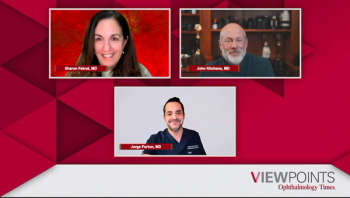
Blog: TAGS trial and real life applications
Joseph Panarelli, MD, and Arsham Sheybani, MD, discuss the Primary Trabeculectomy for Advanced Glaucoma: Pragmatic Multicentre Randomized Controlled Trial, or TAGS trial, and how this can apply to real world situation. This multicenter randomized controlled trial evaluated whether primary trabeculectomy or primary medical treatment leads to improved outcomes in terms of quality of life, clinical effectiveness, and safety.
Editor's note: The views expressed in this blog are those of their respective contributor(s) and do not represent the views of Ophthalmology Times® or MJH Life Sciences®
The Primary Trabeculectomy for Advanced Glaucoma: Pragmatic Multicentre Randomized Controlled Trial, or TAGS, represents a useful clinical study for ophthalmologists caring for patients with open angle glaucoma. This multicenter randomized controlled trial evaluated whether primary trabeculectomy or primary medical treatment leads to improved outcomes in terms of quality of life, clinical effectiveness, and safety.
In the United Kingdom, clinical practice guidelines from the National Institute for Health and Care Excellence (NICE) recommend that primary trabeculectomy should be considered as an initial treatment for advanced glaucoma patients. However, the authors of these guidelines cite minimal supportive evidence. A Cochrane systematic review published in 2012 found that trabeculectomy lowers intraocular pressure more than medical management in patients with open angle glaucoma, although this study excluded patients with advanced disease. The TAGS group aimed to supplement current literature on the management of patients with advanced glaucoma by studying quality of life, clinical effectiveness, and safety outcomes. The primary endpoint was vision specific quality of life using the Visual Function Questionnaire-25 (VFQ-25) at 24 months and secondary endpoints included general health status, glaucoma-related quality of life, clinical effectiveness, and safety.
The study team recruited adults with newly diagnosed untreated advanced open angle glaucoma at 27 centers in the United Kingdom. Upon diagnosis using the Hodapp-Parrish-Anderson classification based on visual field loss, patients with open angle glaucoma including pigment dispersion glaucoma, pseudoexfoliative glaucoma, and normal tension glaucoma were started on medical treatment and randomly assigned to trabeculectomy with mitomycin C or continued medical management in a 1:1 fashion with the participant (not the eye) as the unit of randomization. Due to the interventional design of the study, clinicians and participants were unblinded. Notably, patients with a high risk of trabeculectomy failure were excluded from participation. Patients in the trabeculectomy group used medical treatment while waiting for surgery. If patients in the medical therapy group did not show adequate intraocular pressure reduction despite escalation in treatment including topical and systemic medications, trabeculectomy surgery was offered. Similarly, if trabeculectomy surgery did not adequately control intraocular pressure, surgical patients resumed medical treatment.
The authors recruited 453 participants from 27 clinical sites, with 227 patients in the medical management group and 226 patients in surgical group and used an intention to treat analysis to evaluate the results. The mean age of participants was 67.6 years. Most patients (82.3%) were White and 67% of participants were male. The vast majority of participants (97.5%) were diagnosed with primary open angle glaucoma including normal tension glaucoma and most patients (92.5%) were phakic. Nineteen percent of patients in each arm were diagnosed with advanced glaucoma in both eyes. At 24 months, the mean VFQ-25 scores were similar in the two groups. Although the study found a reduction in intraocular pressure for both groups, a greater reduction was observed in patients who underwent trabeculectomy surgery. The mean intraocular pressure was 12.4 mmHg (SD 4.7) for the trabeculectomy group and 15.1 mmHg (SD 4.8) in the medical therapy group, a statistically significant difference (p<0.001). In addition, at 24 months, fewer patients in the trabeculectomy arm (25%) required topical medications compared to the medical management arm (78%). The logMAR visual acuity was worse in the trabeculectomy group with a mean difference of 0.07 (p=0.006) although there was no difference in visual field mean deviation at 24 months. There was a similar incidence of safety events including serious adverse events in both groups.One participant in each group developed endophthalmitis and three patients in the trabeculectomy group lost more than 10 letters of logMAR visual acuity (advancing glaucoma for two patients and central serous retinopathy one patient). Trabeculectomy patients were more likely to need additional interventions.
The TAGS trial’s results have relevant clinical applications for ophthalmologists caring for open angle glaucoma patients who present with advanced disease. Prior studies such as the Moorfield’s Primary Treatment Trial and Collaborative Initial Glaucoma Treatment Study (CIGTS) provided useful insight into the management of newly diagnosed glaucoma patients, but clinicians may be hesitant to offer surgical intervention as primary therapy.
The current study assists clinicians by demonstrating improved intraocular pressure control with primary trabeculectomy surgery and similar outcomes in terms of quality of life, visual field progression, and safety when compared to medical treatment. Using the study’s findings, glaucoma specialists may feel more comfortable with counseling patients of the option to begin medical management while anticipating prompt surgical intervention when patients present with advanced/severe disease. Furthermore, similar to real-word clinical practice, the authors allowed crossover to occur such that they escalated medical treatment when inadequate control was achieved and patients in the medical therapy group underwent trabeculectomy surgery if needed. Still, for tertiary care centers, the study population may not be generalizable, as patients may be diagnosed and managed in other clinics and referred to glaucoma specialists after their disease progresses with conservative measures, rather than untreated patients with advanced disease initially presenting to a surgeon’s clinic.
Given the aging population and higher life expectancy than in the past, sustained control of disease to maximize functional vision and minimize glaucomatous progression has become increasingly important for clinicians. Developing strong patient relationships and explaining management recommendations using evidence-based medicine is critical to clinical encounters, and the TAGS trial provides additional data that can be presented to patients when discussing treatment options for advanced open angle glaucoma.
Joseph F. Panarelli, MD, is a board certified ophthalmologist and Chief of the Glaucoma division at NYU Langone Eye Center. He specializes in the treatment of glaucoma in both adult and pediatric patients. Dr. Panarelli’s research interests stem from his passion for innovative surgical approaches and primarily include development of surgical devices and techniques. He is also actively involved in graduate medical education as the director of the glaucoma fellowship program at NYU and in teaching residents on the glaucoma service.
Alcina Lidder, MD, studied Psychology and Global Health as an undergraduate student at Northwestern University. After graduation, she attended University of Rochester School of Medicine and Dentistry for medical school. Dr. Lidder is currently a PGY-4 ophthalmology resident at New York University where she serves as a Chief Resident.
Newsletter
Don’t miss out—get Ophthalmology Times updates on the latest clinical advancements and expert interviews, straight to your inbox.

















































.png)


